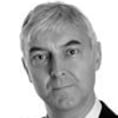It is easy to cycle north out of Niort on country lanes where the sound of a car is an infrequent event. After an hour or so I am back in bocage countryside. I stop outside a sleepy village and get into conversation with retired farmer Michel Rageau (85). I share my view that the fields and low hills made for a landscape like that of the Irish midlands. Rageau tells me the local crops are maize and wheat and that there is also a lot of cattle rearing. He used to keep "30 bêtes" on his farm.
Arriving into Parthenay, a sign announces it is twinned with Tipperary. It has a huge cattle market where a few hundred beasts change hands every Wednesday. It has churches and castles and streets lined with houses that are centuries old.
The way French history has left so much architectural heritage in its towns and cities, combined with a pervasive view that this should be protectedd, and the rural depopulation since the second World War, all give its country towns an odd atmosphere. They can feel underpopulated, forgotten; as if the tide has gone out.
There is less of that air about the centre of Poitiers, which is pedestrianised and has an impressive (socialist-controlled) Hôtel de Ville in cream stone. Given that Poitiers is a university town that loses up to half its population in the summer, I decide it must be a lively place indeed at other times of the year.
There is a wide range of local newspapers in France (French press is subsidised by the state.) In Nantes, the big newspaper is Ouest France but when you get to Niort you are in Courrier de l'Ouest territory. By the time you get to Poitiers the Courrier is no longer available, and the shops are full of La Nouvelle République. The three papers have regional editions and are focused on local news and sport, mixing the most mundane of events (Irish journalist cycles into town – honest!) with coverage of national and international events.
According to Garance Etavard of La Nouvelle République, her newspaper's daily sales of about 180,000 are driven by an appetite for local news.
Ouest France is the country's most popular daily, selling about 800,000 a day, two to three times more than Le Monde, according to journalist Thierry Ballu. It has a series of local editions, and sells in Normandy, Brittany and the Pays de la Loire.
During the second World War its then owner supported the Vichy government and, after the war, control of the title was given to another branch of the collaborator’s family. Its current chief executive, Francois-Régis Hutin, is a member of that family.
“It was set up by religious people,” says Ballu, a staff journalist based in Nantes. “It is Christian Democratic in origin and still has that ethos. It is to the centre, not the right, not the left.”
The words “liberty” and “justice” have appeared under its masthead since liberation, reflecting Hutin’s view that you need to protect against the excesses of both the right and left.
Etavard says the divide between right and left in France is particularly strong now, as was seen in the controversy over same-sex marriage. She says there has been a recent blurring of the division between the right and the far right. “People are no longer ashamed to say they are from the far right. This has increased tension between the socialists and the right.”
For Fiona Casey, my Irish friend who lives in Nantes, her favourite things about France seem to be related to her biggest criticism. She says it is a very well organised country, with great public services, that seeks to provide citizens with a high standard of living in all its aspects (notably food). Yet, she says, the various strong cultural codes as to how people should behave can feel very restrictive.
One thing is for sure; the climate and culture make France an ideal place for cycling trips, not least because of the steak au poivre and pichet de vin that you can reward yourself with when you arrive at each day's destination.
Series concludes












